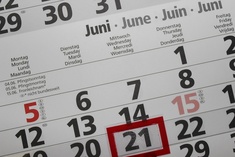
How Calendar Dates Are Written in Different Languages - Part 1
First published: Sunday October 2nd, 2022
Report this blog
Introduction
Since its creation in 1582, the Gregorian calendar has spread to nearly every corner of the world. People now use it to plan their lives, date historical events, and facilitate agricultural activities. However, although the whole world uses the same calendar, people in different countries write the dates on the calendar in different ways. In this blog, I will show you how calendar dates are written in 8 different languages.
1. English (United States)
I think most people are familiar with this one. People in the States write the month first, followed by the day, and lastly the year. To separate the day and the year, which are both numbers, a comma is added in between. For example, the ISO 8601 date "2022-10-01" is written as "October 1, 2022". The day may also be written in ordinal form ("1st" instead of "1", "2nd" instead of "2", etc), e.g. "October 1st, 2022".
2. English (United Kingdom)
People in the UK write dates slightly differently than those in the US: the day number is always written first, followed by the month, and lastly the year (i.e. in a little-endian format). For instance, what would be "2022-10-01" in ISO 8601 is "1 October 2022" in UK English. The day may also be written in ordinal form ("1st" instead of "1", "2nd" instead of "2", etc), e.g. "1st October 2022".
3. French
Similar to the UK date format, dates in French are written out in a little-endian fashion. However, month names in French are different from those in English. They are, in order: janvier, février, mars, avril, mai, juin, juillet, août, septembre, octobre, novembre, décembre. Note that the month names are not capitalized. For example, "2022-10-01" in ISO 8601 is written as "1 octobre 2022" in French, and "2022-07-04" would be "4 juillet 2022". Sometimes, when the day number is 1, "1er" (the French equivalent of English "1st") may be used instead of just "1".
4. German
Dates in German are also written in a little-endian format, i.e. day-month-year. However, some month names in German are different from those in English. They are, in order: Januar, Februar, März, April, Mai, Juni, Juli, August, September, Oktober, November, Dezember. In addition, the day number is always followed by a period (.). For example, the ISO 8601 date "2022-10-01" is written as "1. Oktober 2022", and "2022-07-04" would be "4. Juli 2022".
5. Spanish
Dates in Spanish are written in a little-endian format as well, but it differs slightly from the languages described above. The basic structure of a Spanish date is "[day] de [month] de [year]" (note that the word "de", meaning "of", is in between the date components). Also, Spanish month names are different from those in English. They are, in order: enero, febrero, marzo, abril, mayo, junio, julio, agosto, septiembre, octubre, noviembre, diciembre. Note that the month names are not capitalized. For example, "2022-10-01" in ISO 8601 is written as "1 de octubre de 2022" in Spanish, and "2022-07-04" would be "4 de julio de 2022".
6. Russian
Dates in Russian are also little-endian, but they differ a lot from those in UK English, French, German and Spanish. Firstly, the month names are different. They are, in order: январь (janvar'), февраль (fevral'), март (mart), апрель (aprel'), май (maj), июнь (ijun'), июль (ijul'), август (avgust), сентябрь (sentjabr'), октябрь (oktjabr'), ноябрь (nojabr'), декабрь (dekabr'). Secondly, the word "г." (for "год", meaning "year") is always added to the end. For instance, the ISO 8601 date "2022-10-01" is written as "1 октября 2022 г." in Russian, and "2022-07-04" would be "4 июля 2022 г.". Note that when used in a date, the month names are spelled slightly differently than when they are isolated.
7. Chinese and Japanese
Dates in Chinese and Japanese are pronounced differently but written in the same way. In both languages, dates are written in a big-endian format (year-month-day). The basic structure of a date in Chinese and Japanese is "[year]年[month]月[day]日", with the character "年" meaning "year", "月" meaning "month", and "日" meaning "day". There are no month names in Chinese and Japanese; instead, month numbers are used. For instance, "July" would be "7月" since it's the seventh month of the year. The year and the day are written with numbers, just like all other languages described above. For example, the ISO 8601 date "2022-10-01" is written as "2022年10月1日", and "2022-07-04" would be "2022年7月4日".
Recap
Here's a quick recap of how to write calendar dates in these 8 languages:
| Language | Format | 2022-10-01 | 2022-07-04 |
|---|---|---|---|
| English (US) | M-D-Y | October 1(st), 2022 | July 4(th), 2022 |
| English (UK) | D-M-Y | 1(st) October 2022 | 4(th) July 2022 |
| French | D-M-Y | 1(er) octobre 2022 | 4 juillet 2022 |
| German | D-M-Y | 1. Oktober 2022 | 4. Juli 2022 |
| Spanish | D-M-Y | 1 de octubre de 2022 | 4 de julio de 2022 |
| Russian | D-M-Y | 1 октября 2022 г. | 4 июля 2022 г. |
| Chinese/Japanese | Y-M-D | 2022年10月1日 | 2022年7月4日 |
I hope you enjoyed the read. Please do let me know if you find any errors in this blog (as I don't speak all 8 languages) so I can correct them.
In part 2 I will be presenting how calendar dates are written in 8 other languages. If your language is not here and you want me to cover it, feel free to leave a suggestion in the comments!

Most other Muslim countries, however, follow the Islamic calendar, also called the Hijri calendar, which shares the same epoch as the Persian calendar but follows the lunar cycle only (i.e. the calendar is not synced with the solar year). For them, this year is 1444!